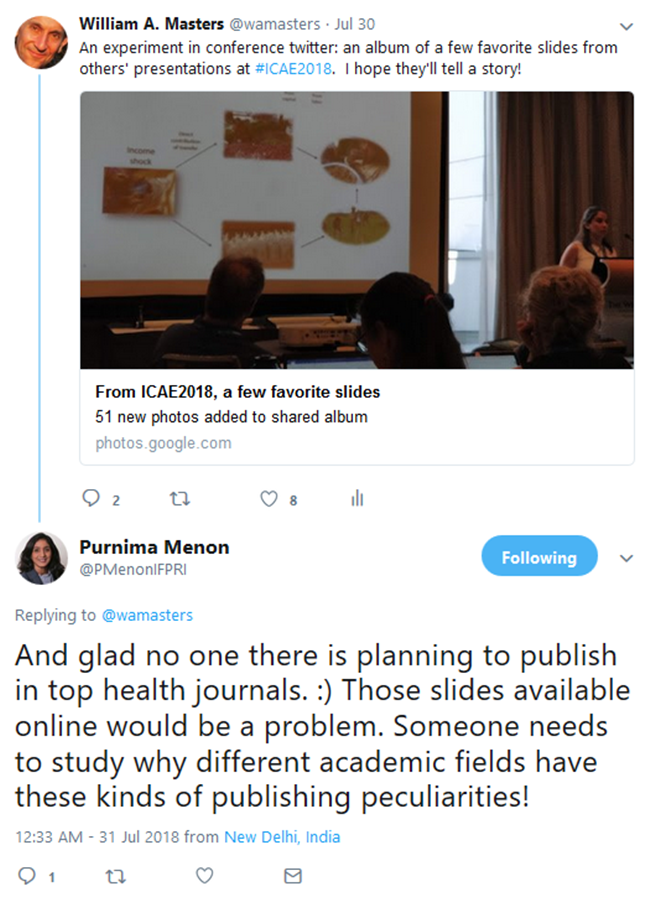Why is so much nutrition research kept confidential before publication?
Research in nutrition and the health sciences is often kept semi-secret until publication. Why? Does it matter?
Scientists in many fields circulate their work in progress as widely as possible, hoping for feedback and citation even before submission to a journal. Institutions run their own working paper series (like the Tufts economics department), individuals use their own websites (like my personal site), and many use general repositories (like arXiv and SSRN). Acceptance at a top journal certifies the quality of the final version and facilitates dissemination, but draft work in the physical and social sciences is typically circulated as widely as possible before publication.
In nutrition and health research, the default rule is secrecy. Results are typically kept confidential until publication, even for work that will be eventually be published on an open-access basis. Study designs for human subjects research is disclosed through registries like clinicaltrials.gov, and ongoing work may be described at conferences from which brief abstracts are published in outlets like the FASEB supplements, but detailed methods and results are not generally shared until publication day.

The difference between fields is nicely illustrated by a twitter thread reproduced in this post, in which I experimented with sharing a photo album from an agricultural economics conference so as to see connections between different presentations. That led to quick reply from a leading nutrition researcher, Purnima Menon, who noted that posting photos of slides could jeopardize publication in top health journals.
A specific example of how nutrition research is kept hidden until publication comes from a recent conference that I organized at Tufts, called GlobalFood+. This event was designed around 7-minute speed talks designed for sharing on the internet — but one of the best talks had to be kept off our website.
Confidentiality of work in progress can be important to prevent theft of ideas, to ensure that scientists receive credit for what they do. Limiting prior publication might also be important for subscription-based journals, to ensure that institutional libraries want that journal in their collection. But neither rationale applies when working papers can be cited, and when publication fees are paid for open-access articles.
In general, the primary reason to discourage prior sharing is to pursue media coverage. Journal publishers make this clear, as in the statements against ‘pre-publicity’ at the top general outlets, Nature and Science. Previous posting is especially discouraged in the top medical journals, as explained by JAMA and NEJM. They encourage publication of teaser abstracts, like a movie trailer, but detailed results are subject to a media embargo until publication day. Universities and research labs are keen to cooperate, in the hope that science journalists will treat the paper’s arrival as a newsworthy event.
Embargoes may be needed in some case, but for most studies the scientific community is turning against pre-publication secrecy. Treating publication as a news event is itself a problem, contributing to ‘study-a-day’ media coverage that exaggerates the importance of new studies relative to previous knowledge. And limiting prior scrutiny to a handful of referees and editors raises the risk of error. Policies favoring prior circulation of working papers were adopted long ago in PNAS, and have recently been adopted in the health sciences at BMJ and The Lancet. In nutrition, the AJCN and Journal of Nutrition still put some limits on prior circulation, discouraging their use.
Why would different kinds of journals have different policies? One factor could be audience demand for different kinds of news. Many people want to know about the latest findings in nutrition and medicine, so media outlets often assign reporters to meet that need. Universities are happy to supply a curated flow of individual studies in the specific fields that reporters most want to write about, like dietary advice and lifestyle choices. Managing the flow of news is also important for high-stakes pharmaceutical trials and other controversial studies. But in many cases, secrecy before publication is sought mainly to protect the economic interests of the publisher. With JAMA, NEJM and some others, subscriptions are still important so they must restrict prior publication to enforce a paywall. And some journals like Science and Nature run scientific articles alongside weekly news about science, with significant revenue from ads for lab equipment and materials. These journals need publicity to attract traffic for their journal as a news source, to sell both subscriptions and advertising.
Scientific work is changing fast and it’s hard to keep up. For example, my previous foodecon post was about how to limit the plague of academic spam. Much is being written about the business of scientific publication, including great nonprofit work by Scholarly Kitchen and the EmbargoWatch blog by Ivan Oransky (who also blogs at RetractionWatch), as well as superb reporting on academic life by insidehighered.com and chronicle.com. Personally, I hope that the tradition of pre-publication secrecy is soon replaced by wider circulation of working papers, even in nutrition and the health sciences. Sharing work in progress would raise overall quality, and help break reporters’ study-a-day habit and encourage them to cover the overall flow of knowledge. Wouldn’t that be nice?
